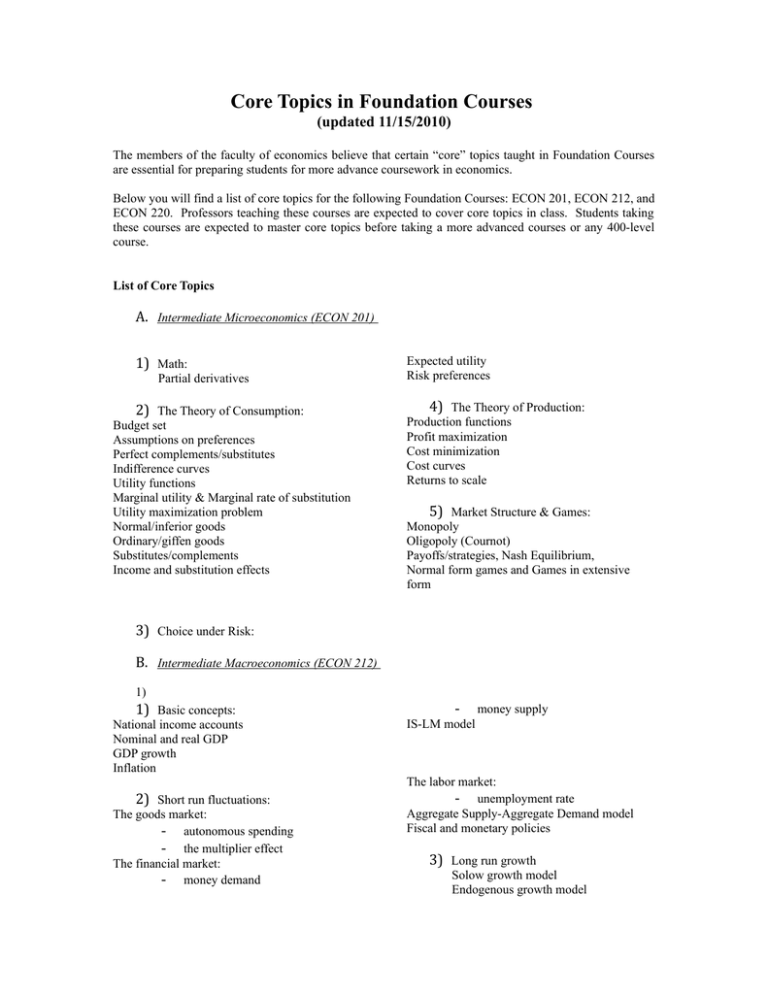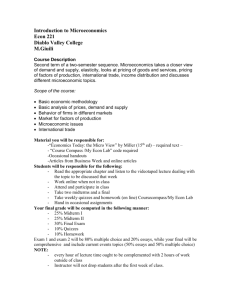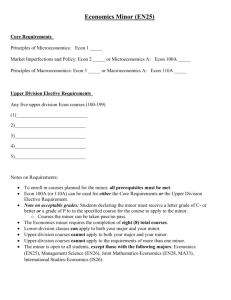Core Topics in Foundation Courses (updated 11/15/2010)
advertisement

Core Topics in Foundation Courses (updated 11/15/2010) The members of the faculty of economics believe that certain “core” topics taught in Foundation Courses are essential for preparing students for more advance coursework in economics. Below you will find a list of core topics for the following Foundation Courses: ECON 201, ECON 212, and ECON 220. Professors teaching these courses are expected to cover core topics in class. Students taking these courses are expected to master core topics before taking a more advanced courses or any 400-level course. List of Core Topics A. Intermediate Microeconomics (ECON 201) 1) Math: Partial derivatives 2) The Theory of Consumption: Budget set Assumptions on preferences Perfect complements/substitutes Indifference curves Utility functions Marginal utility & Marginal rate of substitution Utility maximization problem Normal/inferior goods Ordinary/giffen goods Substitutes/complements Income and substitution effects Expected utility Risk preferences 4) The Theory of Production: Production functions Profit maximization Cost minimization Cost curves Returns to scale 5) Market Structure & Games: Monopoly Oligopoly (Cournot) Payoffs/strategies, Nash Equilibrium, Normal form games and Games in extensive form 3) Choice under Risk: B. Intermediate Macroeconomics (ECON 212) 1) 1) Basic concepts: National income accounts Nominal and real GDP GDP growth Inflation 2) Short run fluctuations: The goods market: - autonomous spending - the multiplier effect The financial market: - money demand - money supply IS-LM model The labor market: - unemployment rate Aggregate Supply-Aggregate Demand model Fiscal and monetary policies 3) Long run growth Solow growth model Endogenous growth model Policy implications 4) Open economy Nominal and real exchange rates Balance of payments Exchange rate regimes C. Introduction to Statistical Methods (ECON 220) 1) Statistics and Measurement: Population and sample data: statistical inference 2) Frequency distribution, histogram, and scatter diagram Measures of location: mean, median, mode Measures of variability: range, variance, standard deviation, coefficient of variation; z-scores, empirical rule Measures of Association: covariance, correlation 3) Probability, Random Variables, and Expected Values: Rules of probability and independence Random variables, expected values: mean, variance 4) Discrete Probability Distributions: Bernoulli, binomial 5) Continuous Probability Distributions: Normal, standard normal Student’s-t 6) Estimation and the Sampling Distribution of an Estimator: Sampling Statistical inference, point estimation Sample mean, sample proportion and central limit theorem Interval estimation of a population mean Interval estimation of a population proportion 7) Hypotheses Testing: General principles, Type I and Type II errors z and t test of a population mean z test of a population proportion 8) Bivariate Relationship and Regression: The regression line and least squares estimation Statistical inference on the slope and intercept






